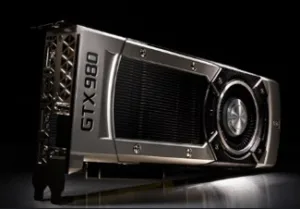The Maxwell architecture introduced by Nvidia as the eventual successor to Kepler (Display Monitor Vol 21 No 8) now has two new GPUs: the GTX 970 and 980. Maxwell is more efficient than Kepler, as it can enable various cores individually. Power consumption has even been improved compared to the first-generation Maxwell cards, the GTX 750 and GTX 750Ti, by as much as 50%, requiring 165W and 145W, respectively.
Both new cards are targeted at hardcore gamers requiring high-end graphics. As Maxwell units, they use Nvidia’s ‘Dynamic Super Resolution’, a downsampling feature. Content retains some elements from its original form, whether it is scaled down or up – we saw an example of this at IFA 2012, when talking to a Toshiba engineer (Display Monitor Vol 19 No 35). Effectively, the filters are not perfect and so quite a lot of detail remains in the content. By rendering a game in UltraHD and downscaling it to 1920 x 1080, the Maxwell GPUs provide sharper imagery. Nvidia’s technical marketing manager Andrew Coonrad told Wes Fenton, of PC Gamer, “[I]f the game is compatible with 4K, it will be compatible with this technology”.
Additionally the GTX 980 and 970 include multi-frame sampled anti-aliasing (MFAA), the successor to multisample anti-aliasing (MSAA); as well as the smoother edges seen when using MSAA, Nvidia says there will be no performance compromises with MFAA. They are also (apparently) the first to use Voxel Global Illumination, in an attempt to provide more realistic lighting. Game developers can draw on this tool in Nvidia’s Gameworks programming library.
The final Maxwell technology is called VR Direct: dedicated support for VR gaming. It is designed to raise performance, lower latency and increase compatibility for VR headsets like the Oculus Rift.
In addition to the above, both cards support Nvidia’s G-Sync, ShadowPlay, GPU Boost 2.0, Adaptive V-Sync, PhysX and 3D Vision technologies.
The GTX 980 has 2,048 CUDA cores, a base 1,126MHz base clock (1,216MHz boost clock) and 5 TFLOPS performance. The GTX970 has 1,664 cores, a base clock speed of 1,050MHz (1,178MHz boost clock) and 4 TFLOPs of performance. Both use 4GB of 256-bit GDDR5 memory and a PCI-e 3.0 bus. They support resolutions up to DCI-4k and feature DisplayPort (x3), HDMI and dual-link DVI-I connections. Up to four displays can be driven at one time.
Available today, the GTX 980 costs $550 and the GTX 970 costs $330.

